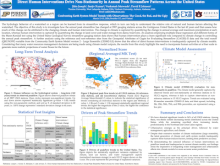Direct human interventions dominate the non-stationary response in peak annual streamflow in the United States
Sanjiv
Kumar
Auburn University
Poster
Climate change and direct human interventions, such as land-use change and water management, causes non-stationarity in streamflow predictions. However, their relative influences including direction of change and spatial extent are not studied at a continental scale. Hence, their implications for developing high-fidelity climate models are largely unknown. This study presents a novel assessment of the major drivers of non-stationarity in peak annual streamflow using observations and a large ensemble climate data. Sixty-years of longer streamflow observations from 3907 United States Geological Survey (USGS) sites are employed; out of which 72% sites are impacted by the direct human interventions. The peak annual streamflow show statistically significant trends at 34% of the USGS sites with 21% sites showing decreasing trends and 13% sites showing an increasing trends. A regional Mann-Kendall test show a decreasing trend in most of the United States except for the Northeastern part and the upper Great Lakes region which show an increasing trend. A multiple linear regression model at regional scale shows that water management is the major driver, followed by urbanization, agriculture, and climate. The water management explains most variability, e.g., up to 39%, and 38% in the Upper Colorado River basin, and the Tennessee region, respectively. The predominant decreasing trend in the Ohio River Basin is mostly explained by the water management. Urbanization is the major driver of peak flow trends in the Mid-Atlantic, and California regions. Neither water management, nor urbanization are adequately represented in the state-of-the-art climate models, limiting their ability to capture the observed peak flow trends. However, climate model performance improves after removing the human impacted sites from the analysis. This study underscores the need to include direct human interventions in the climate model; and therefore supports the USGS’s revised water cycle diagram with human interventions as one of the major driver.

Poster file
kumar-sanjiv-confronting-poster.pdf
(2.29 MB)
